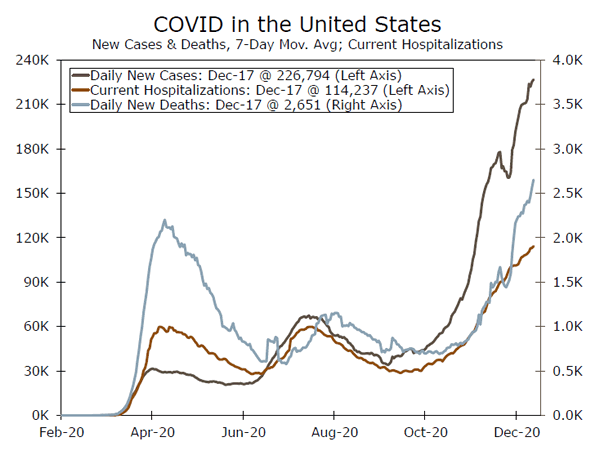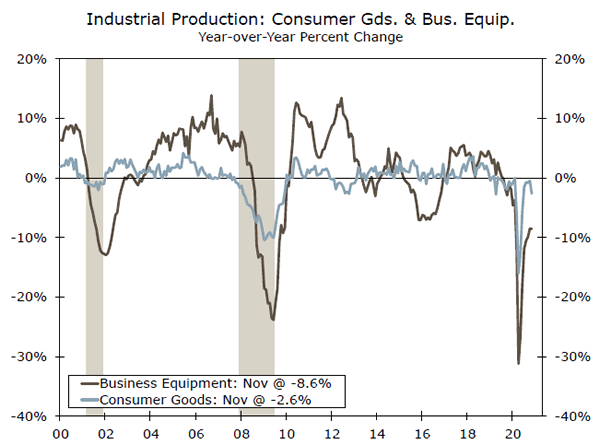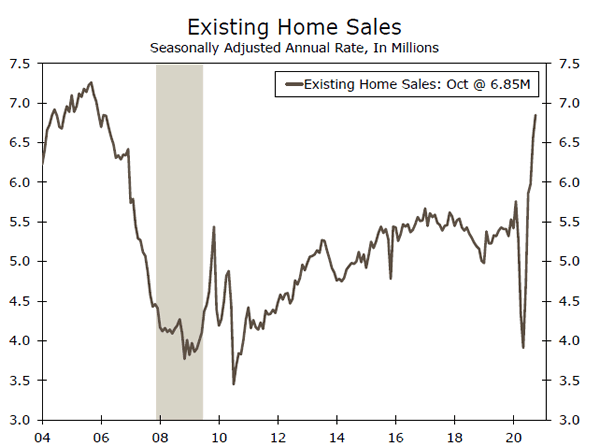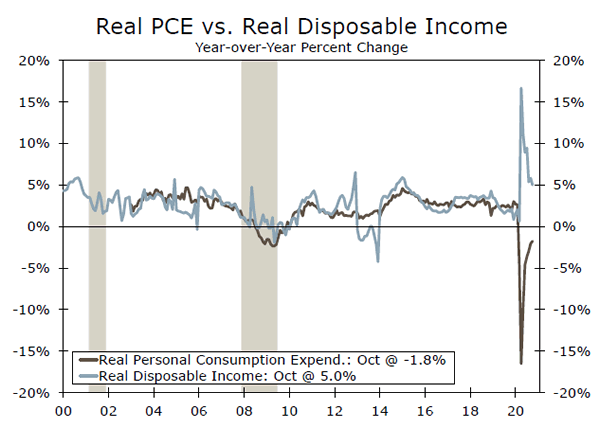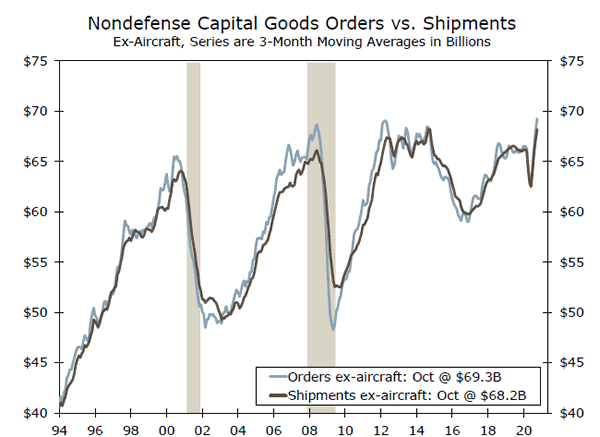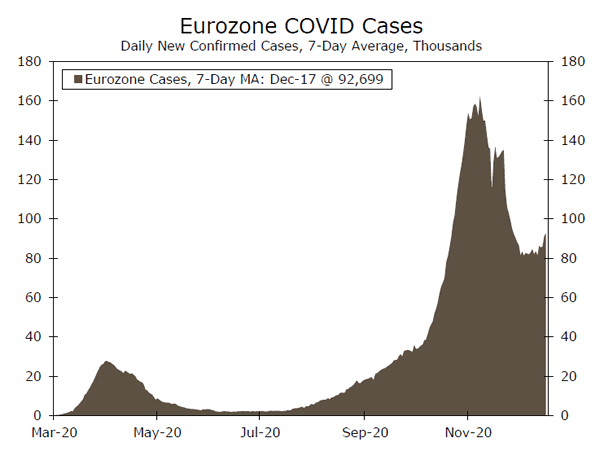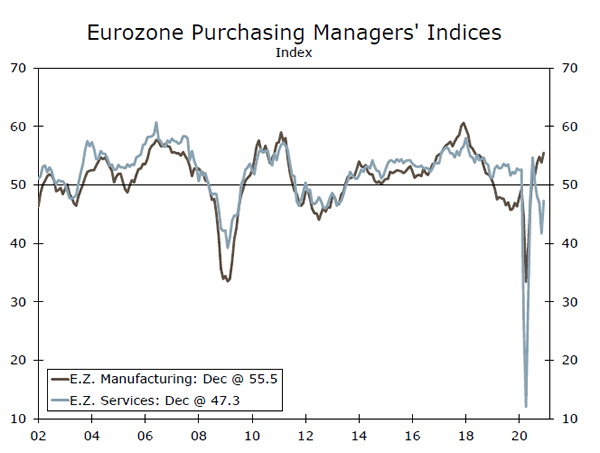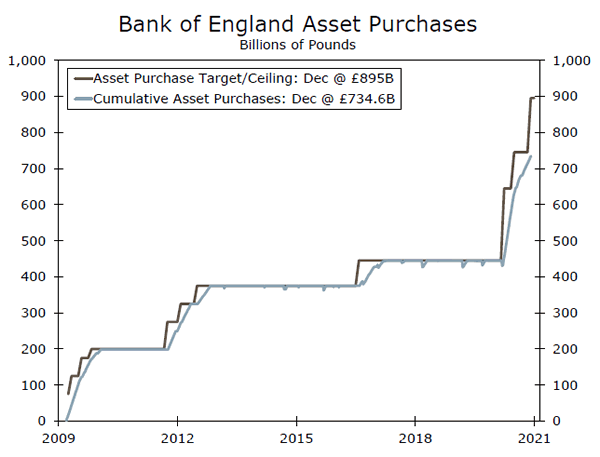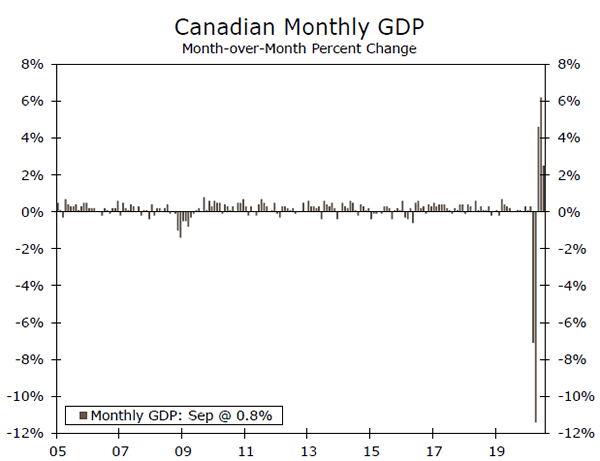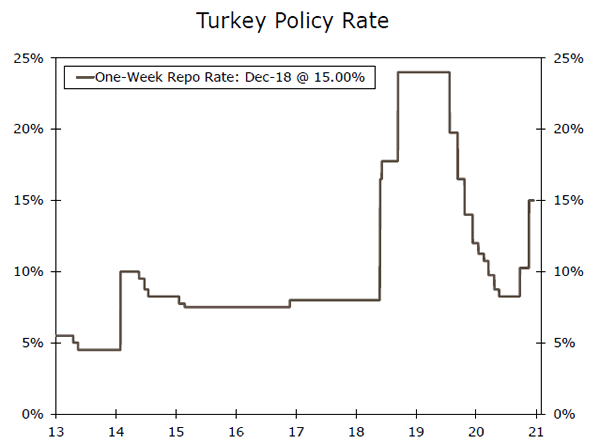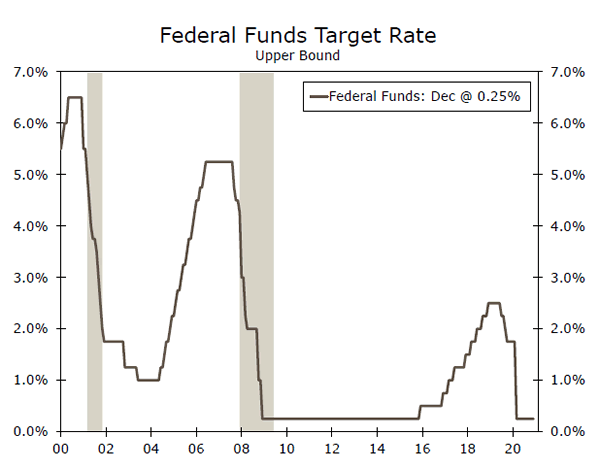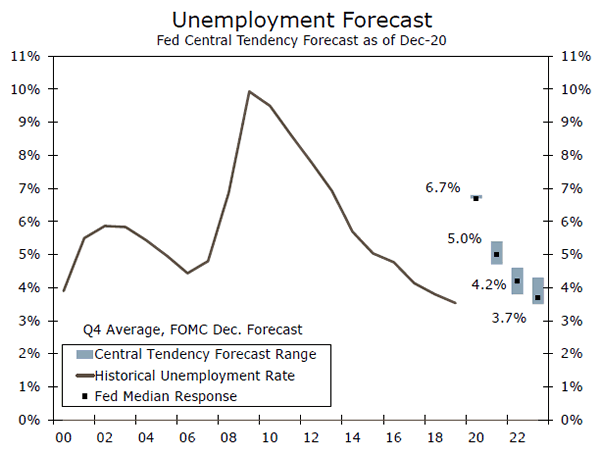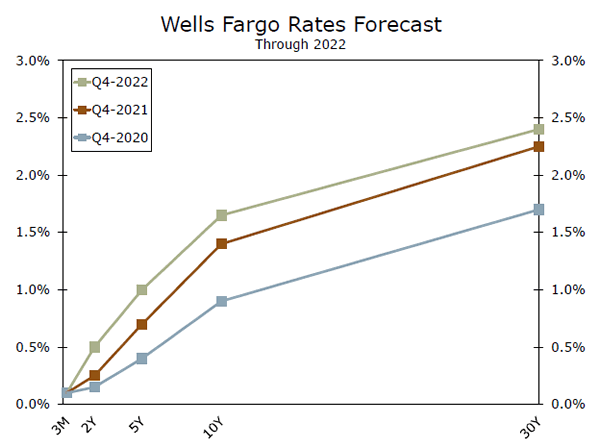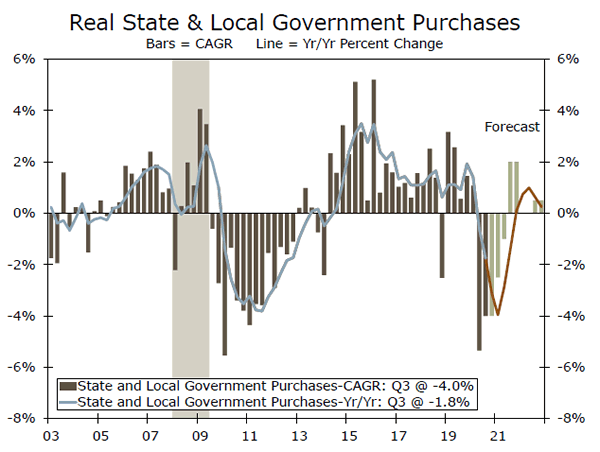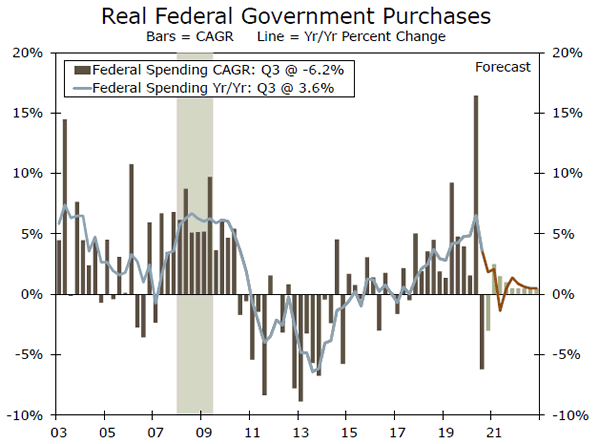U.S. Review
The Shot Heard Round the World
- This week marked the first U.S. COVID vaccinations and the imminent rollout of a second vaccine. But, the resurgence of the virus and increased mobility restrictions further show why fiscal support would help ensure the economic recovery.
- The highest number of individuals since September filed an initial claim for unemployment last week.
- Retail sales missed expectations in November and foreshadow the impending air pocket for durables consumption, which will also have implications for the rebound in manufacturing.
- Housing remains a bright spot with starts up 1.2% last month.
The Shot Heard Round the World
The first U.S. COVID vaccinations began on Monday, just days after the Pfizer-BioNTech vaccine received FDA emergency authorization. On Thursday, a second vaccine, the Moderna COVID vaccine, was recommended for approval by medical advisers to the FDA. FDA emergency authorization is imminent.
News of the second vaccine comes following the deadliest day of the pandemic yet in the United States as the virus rages across the nation. The resurgence of the virus continues to lead to more mobility restrictions to curb the spread of the virus causing businesses to close and lay off workers as a result, who again are increasingly turning to unemployment benefits for assistance. Last week, 885K additional workers filed an initial claim for unemployment insurance, marking the second consecutive weekly increase and the highest reading since early September. The rise in claims came during the nonfarm payroll survey week, which increases the odds of a negative print for December employment.
A total of 20.6 million individuals continue to collect some form of unemployment insurance, with 14 million relying on assistance from a temporary program (such as PUA or PEUC). With the December 26 expiration of these temporary enhanced benefits quickly approaching, all eyes remain on Congress if an additional COVID-relief package will come to pass. We now view it more likely than not that a relief bill will become law and will include among other things, the extension of enhanced benefits. See Topic of the Week on Page 8 for more detail on COVID-relief.
Impending Air Pocket in Goods Consumption
The economic data this week foreshadowed the impending air pocket we expect for goods consumption, which has soared since the lifting of lockdowns in April. Retail sales declined a more-thanexpected 1.1% in November. The decline in sales likely, in part, reflects renewed concern of the virus as nonstore retailers (online sales), grocery stores and building material stores—retailers that benefited at the onset of the crisis—were the only three retailers to report an increase in sales during the month. The retail figures suggest some downside risk to durables consumption in the fourth quarter, but our holiday sales (HS) forecast for a 9% year-over-year gain remains more or less intact. Since HS exclude some of the categories that are struggling, like gas stations, autos and restaurants, the decline in November HS was just 0.3%. We would not be surprised to see December post a modest decline as well, but since HS are coming off such a high level of spending already, a big year-over-year increase is still in the cards.
The composition of consumer spending favoring goods outlays has benefited manufacturing, which advanced 0.8% in November. But, total manufacturing output remains 5% shy of its pre-virus peak and the anticipated slowdown in goods outlays suggests a sputtering in industrial production, particularly in categories that have outperformed recently, like consumer goods and information processing equipment. Therefore, the upside of the country and the world getting back on its feet will also mean a shift in spending back to the services economy, which means less wallet-share for durable goods purchases. At that point, it will fall to business spending on equipment to pick up the slack and become the locomotive of growth for manufacturing production.
U.S. Outlook
Existing Home Sales • Tuesday
The housing market’s hot streak continued in October as existing home sales blew past expectations and reached a 6.85-million-unit annualized pace, the highest reading since 2006. Inventories dropped to 1.42 million, 19.8% below year-ago levels, and month’s supply fell to 2.5 months, the lowest on record. Home prices are soaring thanks to scarce supply and robust demand. Median single-family home price rose 16% from a year ago to $317,700.
While we expect this strong pace of sales to continue, the rate of improvement may soon slow. Pending home sales, which lead existing sales by a month or two, fell 2.0% in September. Similarly, mortgage purchase applications have started to come back down from the lofty heights reached this summer. We look for a modest decline in November’s existing home sales to a 6.78-million-unit annualized pace. Even at this slightly lower level, however, the housing sector remains a bright spot of the 2020 economic recovery.
Previous: 6.85 Million Wells Fargo: 6.78 Million Consensus: 6.70 Million (SAAR)
Personal Income & Spending • Wednesday
November appears to be the month in which the spike in COVID cases began to take a bite out of economic activity. Retail sales fell by 1.1% in November, the biggest decline since April, and nonfarm payrolls grew by just 245,000. Subsequently, personal income and spending were probably both flat to down modestly in November.
The 2020 COVID recession has been historically unique in that real disposable income growth and real personal consumption completely diverged earlier in the year (chart to left). Government restrictions and behavioral changes drove a historic collapse in consumption, while fiscal support provided an income bridge for millions of impacted workers. But, as this fiscal support continues to fade, and as job gains have slowed to a trickle despite around 10 million fewer employed workers than in February, another round of COVID relief from Congress could be the critical bridge to warmer weather and widespread distribution of a vaccine in late spring.
Previous: -0.7% Wells Fargo: -0.2% Consensus: -0.3% (Personal Income, Month-over-Month)
Durable Goods Orders • Wednesday
Durable goods orders have continued to surprise to the upside amid a factory sector recovery that has remained on track despite the acceleration in COVID cases. Nondefense capital goods orders ex-aircraft rose 0.8% in November and are now comfortably above pre-pandemic levels. The 2020 dip in core orders and shipments was much smaller than the declines during the previous two recessions, and the bounce back has been sharper (chart to right). Investment plans are rising, and there may be some pent-up demand for capex since equipment spending peaked a full year before the pandemic.
We look for another gain, albeit a smaller one, for durable goods in November. Core capital goods shipments are a key input into our forecast for current quarter equipment spending. We upwardly revised our equipment spending forecast for Q4-2020 in our latest update, and we now look for real equipment spending to be up 1.7% year-over-year in Q4.
Previous: 1.3% Wells Fargo: 0.7% Consensus: 0.6% (Month-over-Month)
Global Review
Lockdowns in Eurozone Likely to Weigh on Q4 Growth
- The Eurozone’s manufacturing PMI unexpectedly rose in December, while the services PMI jumped more than expected. Despite the pickup in survey data, the near-term outlook for the Eurozone economy remains negative, given the renewed COVID spread and associated lockdown measures.
- The Norges Bank held its benchmark rate at zero at its monetary policy meeting this week, but the tone of the accompanying statement was somewhat hawkish. The central bank lifted its projected rate path, now projecting a rate hike in early 2022. Meanwhile, the Bank of England also met this week, leaving its policy rate unchanged at 0.10%.
Eurozone PMIs Surprise to the Upside in December
Eurozone survey data improved in December. The manufacturing PMI increased 1.7 points to 55.5, a 31-month high, while the services sector PMI jumped 5.6 points to 47.3—both exceeding market expectations. The survey indicated that new orders for goods rose more quickly in December, while overall employment fell at its slowest pace in 10 months, suggesting some signs of stabilization in the labor market. The slower fall in employment was in part due to optimism about the year ahead. Business expectations about output in the coming 12 months rose to the highest level since April 2018, and sentiment about future prospects also improved. On a national level, Germany’s manufacturing and services PMIs jumped to 58.6 and 47.7, respectively, while France’s PMIs also increased.
In contrast to this positive news, the Netherlands and Germany— the region’s largest economy—announced a hard lockdown this week as COVID cases reached new record highs. As of Wednesday, all non-essential shops in Germany will be closing until at least January 10, while children in schools and nurseries are encouraged to stay home, among other social distancing measures. Despite the encouraging December PMI surveys, the stricter lockdowns across some Eurozone countries were likely not fully reflected, and the near-term outlook remains challenging. The renewed COVID spread and associated restrictions should prompt a renewed decline in Q4 GDP.
Norges Bank’s Hawkish Statement
At its policy meeting this week, the Norges Bank opted to hold its policy rate steady at zero, as widely expected, but the accompanying statement was somewhat hawkish in tone. Policymakers acknowledged that the surge in COVID cases and resulting stricter containment measures have weighed on activity, but indicated that there are prospects for a faster recovery in 2021 due in part to positive news on the vaccine front. The policy rate path was lifted more than expected, now showing a rate at the current level over 2021, but a gradual rise from the first half of 2022. After today’s policy meeting, we now see the risks tilted toward a first rate hike sometime in early 2022. This week’s statement also included updated economic forecasts. The central bank slightly downgraded its mainland GDP growth projections for Q4-2020 and Q1-2021, while the projections for the rest of 2021 were revised higher. As for inflation, underlying inflation has been somewhat lower.
BoE on Hold Ahead of Brexit Transition Deadline
The Bank of England (BoE) also met this week, keeping its Bank Rate at 0.10% and its total asset purchase target at £895B. This week’s meeting comes just ahead of the December 31 deadline for a Brexit trade deal. The BoE noted that in the case of a no-deal, it could increase the pace of asset purchases. Our base case remains for the BoE to hold monetary policy steady over our forecast horizon, and that a last-minute deal will be struck, although any strength in the pound following a deal should be short-lived.
Global Outlook
Sweden Economic Tendency • Tuesday
Despite the Swedish government opting for a somewhat stricter lockdown to keep the second wave of COVID under control, the Swedish economy appears to be holding up. Confidence indicators were, for the most part, encouraging in November, with the economic tendency survey gaining 1.5 points to 97.5. The improvement was due in part to stronger signals from the manufacturing sector. The confidence indicator for the manufacturing industry increased 4.2 points to 110.6; however, the consumer confidence indicator fell 0.9 points to 88.3, due to more negative expectations in terms of both personal finances and the overall economy. Next week’s release of the December confidence surveys should provide additional insight into how consumers view the Swedish economy amid the COVID outbreak. Retail sales for November will also be released, which will give some additional detail of the impact from local restrictions and the second wave of the virus on overall GDP growth.
Previous: 97.5
Canada Monthly GDP • Wednesday
The Canadian economy appears to still be on a good path despite an uptick in COVID cases across Canada. Q3 GDP rebounded 40.5% quarter-over-quarter (annualized), a bit less than consensus expectations, but the details of the report were sturdy. Consumer spending rose 62.8% quarter-over-quarter and business investment rose at an 82.4% pace. On a monthly basis, September GDP rose 0.8% month-over-month, missing the 0.9% expection.
Next week, we will get the latest insight into how the Canadian economy is holding up in the fourth quarter with the release of the October GDP indicator. Although growth will likely slow in the months ahead, the economy appears to have maintained decent momentum heading into the fourth quarter.
Previous: 0.8% (Month-over-Month)
Turkey Rate Decision • Thursday
In early November, President Erdogan removed the head of the central bank for failing to stabilize the currency and appointed former Finance Minister Naci Agbal as Turkey’s new central bank governor. With a technocratic replacement, market participants had high expectations for a more orthodox policymaking framework, and Agbal delivered, with a significant interest rate hike. At its November policy meeting, the central bank increased its one-week repo rate 475 bps to 15.00%, and said all funding will be provided through the main policy rate. After November’s significant rate hike, we look for the policy rate to remain steady at 15.00% at next week’s policy meeting.
President Erdogan continues to comment on unorthodox monetary policies and fundamentals in Turkey remain weak, with Turkey’s CPI inflation still elevated at 14.03% year-over-year in November. Going forward, markets are likely to continue to question the independence of the central bank.
Previous: 15.00% Wells Fargo: 15.00% Consensus: 16.50%
Point of View
Interest Rate Watch
Fed to Keep Buying Assets
The FOMC concluded its last policy meeting of the year on December 16 and, as widely expected, made no changes to its current target range for its main policy rate (top chart). Nor did the committee alter its monthly purchase rate of Treasury securities ($80 billion per month) or mortgage-backed securities ($40 billion). That said, the FOMC did make a tweak to its outlook regarding the length of time that it will continue to purchase assets.
Previously, the FOMC said it would continue its asset purchases “over coming months.” In the statement that was released this week, the FOMC said that asset purchases would continue “until substantial further progress has been made toward the Committee’s maximum employment and price stability goals.” The meaning of “substantial progress” is vague, and the term offers little clarity on the length of time during which the Fed will continue its asset purchases. But, presumably the FOMC is indicating that purchases will continue for longer than just “coming months.”
In that regard, the Summary of Economic Projections that was released at the conclusion of the meeting was enlightening. The median forecast for the unemployment rate at the end of 2021 among the 17 committee members was 5.0% (middle chart). Furthermore, the median forecast for the PCE inflation rate at the end of next year was 1.8%. Reasonable observers can debate whether “substantial progress” has been made toward “maximum” employment if unemployment has receded to 5.0% at the end of next year from its current rate of 6.7%. Likewise, PCE inflation was 1.2% in Q3-2020. Has “substantial progress” been made if inflation remains below 2% at the end of 2021?
The upshot is that we believe the Fed will continue to purchase both Treasury securities and MBS at their current rates through the end of 2021. The yield on the 10-year Treasury security has risen about 40 bps from its summer low of 0.50%, and it likely will grind higher as the economy continues to recover. However, Fed purchases likely will prevent any sharp rise in long-term interest rates for the foreseeable future (bottom chart).
Credit Market Insights
Funds Still Flowing to Households
The net worth of U.S. households grew $3.8 trillion in the third quarter, according to data released last week in the Fed’s quarterly Financial Accounts of the United States. The increase was largely owed to the rising stock market, with the value of directly and indirectly held corporate equities rising $2.8 trillion. The roughly $450 billion increase in the value of real estate held by households as well as the still high saving rate also contributed to the household sector’s improving financial health. While this aggregate picture hides the struggles of households at the lower end of the wealth spectrum, the resiliency of household balance sheets is nonetheless an encouraging sign as we head into a difficult winter for the U.S. economy.
Among nonfinancial businesses, debt outstanding declined at a 0.9% annualized rate after dizzying growth in the prior two quarters. Much of this decline came from nonmortgage depository loans, which had grown rapidly in the first quarter when businesses tapped existing lines of credit in anticipation of the impending economic storm. A similar phenomenon, along with record low interest rates, also helped fuel surging bond issuance. Corporate bond debt, which makes up the bulk of nonfinancial corporate debt, is up 11.6% from this time last year after increasing by roughly $680 billion since the end of 2019. Debt among smaller, noncorporate businesses has also grown at a healthy clip, increasing 9% over last year to $6.6 trillion.
Topic of the Week
The Eleventh Hour COVID Relief Push
Congress is still working to sort out both funding for the federal government and a COVID-relief plan. On the government funding side, an omnibus bill that funds the federal government through the end of the current fiscal year (September 30) appears increasingly likely. But, if the government is funded through September 30, these few days before the holidays might mark the final “hard” budget deadline of the fiscal year. This, in turn, has spurred another push to find a solution on COVID relief.
Recent negations have been some of the most fruitful in this months-long stimulus saga and we believe a COVIDrelief bill becoming law is now more likely than not. The details remain uncertain, but we suspect a package would look something like this: a few hundred billion dollars in small business aid, around $150 billion for direct household checks, a couple hundred billion dollars in unemployment benefits, spent by extending the Pandemic Unemployment Assistance (PUA) and Pandemic Emergency Unemployment Compensation (PEUC) programs and boosting all benefits by roughly $300 per week, and a couple hundred billion dollars for schools, transit agencies, vaccine distribution and other miscellaneous items. It seems that the two thorniest items, direct state and local aid and COVID liability shields, have been tabled for future debate.
So, what happens next? Congress may pass yet another continuing resolution to buy some more time, perhaps pushing the December 18 funding deadline into the middle of next week. If this does not happen, there could be a short partial federal government shutdown that begins tonight at midnight. While an omnibus bill that funds the government to the end of the fiscal year is already baked into our baseline forecast, the addition of a COVID-relief bill would add upside risk to our outlook. Qualitatively, a fiscal package in the ballpark of $700 billion-$900 billion would go a long way toward smoothing over what we expect to be a relatively weak period for economic growth over the next few months.




